Spring Consulting Group is contracted with the State of Maine to conduct actuarial studies of the Maine Paid Family & Medical Leave (PFML) trust fund. You can read the full press release here.
We’re excited to announce that our Senior Consulting Actuary, Nick Frongillo, was featured in Captive International’s FORTY Under 40 Awards this year! The award spotlights the most influential figures in captive insurance under the age of 40. You can find his winner Q&A responses here.
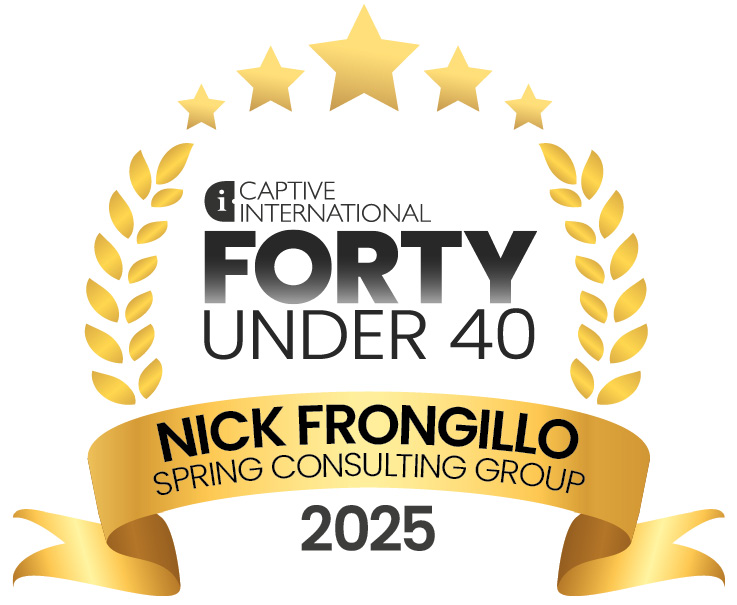
Captive International recently released its Forty Under 40 Awards, which spotlights the top industry leaders under 40 years old impacting captive insurance. We are excited to announce that four of our colleagues were on this list this year! You can find the full list here.
Prabal Lakhanpal (Senior Vice President)
Nick Fongillo (Senior Consulting Actuary)
Aviel Shalev (Consultant)
Spencer Towle (Analyst)
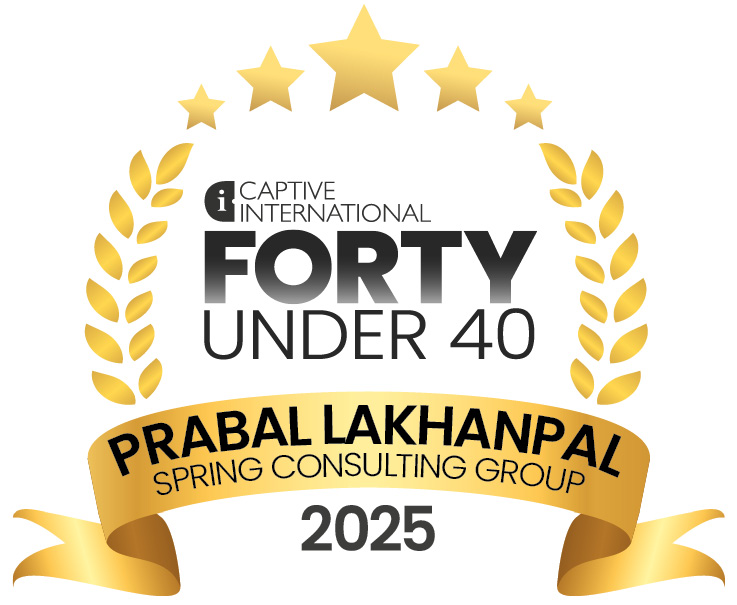

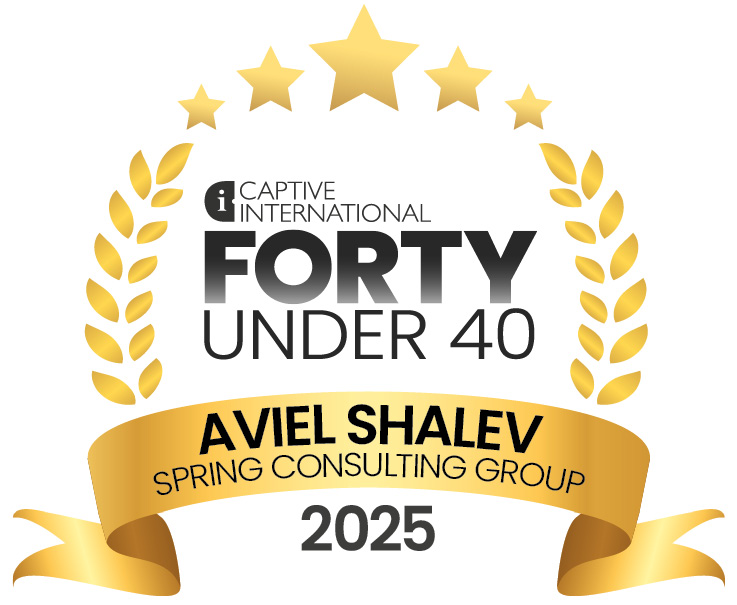
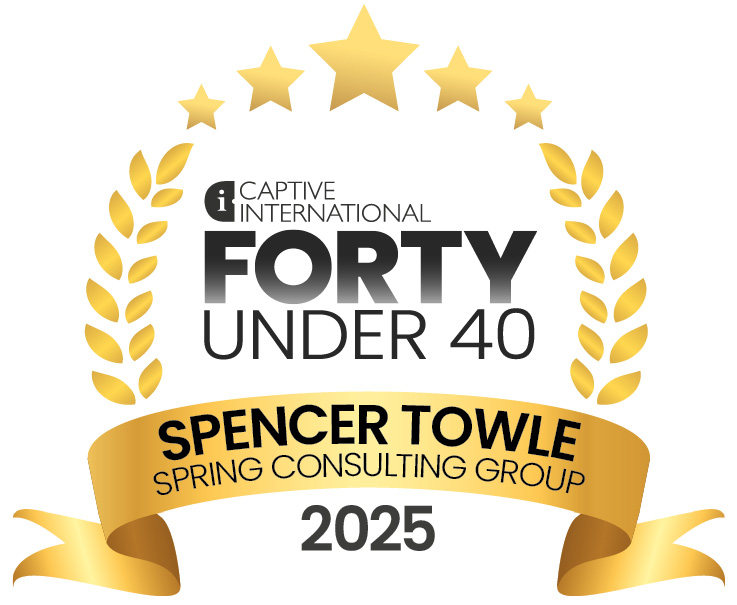
Workforce populations tend to be diverse in terms of demographics as well as other factors such as geography. This is one of the primary reasons healthcare programs are aligned with and sponsored by employers. These programs aim to achieve high enrollment to accommodate the demographic diversity among members. This, in turn, creates a system where the highest utilizers are subsidized by the leanest. There are several typical drivers that affect utilization: age, gender, morbidity, family size, etc. For mature populations participating in employer-sponsored healthcare programs, new hires with more favorable demographic characteristics help offset rising costs for aging employees, providing a consistent balance between those subsidizing and those being subsidized.
One of the largest demographic drivers of cost is age. As age increases, so do costs. When a population has aging members staying on well beyond 65, it becomes difficult to maintain the same influx of younger members to offset these rising costs. There are many industries where employees tend to work beyond age 65, such as education, public administration, and real estate. Additionally, due to rising retirement costs and increases in the cost of living, it has become necessary for many individuals to work beyond the traditional retirement age. The result is an average age that dramatically increases over time and average plan costs that outpace already burdensome medical and pharmacy trend rates.
How can we control these ongoing costs?
In general, there are many levers typically used to control healthcare costs. Many of them still make sense in the present environment, though they may be unattractive in a competitive employment situation. Examples include increased employee cost-sharing, leaner healthcare offerings, more stringent participation requirements, disease management, utilization management, and leaner pharmacy formularies.
How can we specifically address older members?
In the case of consistently increasing average age, these cost-control approaches may be temporary and insufficient. Further steps may include such approaches, but employers may also seek to decrease the number of older members remaining enrolled in the plan. Some specific suggestions include:
- Salary-banded employee contributions – This involves charging scaled contributions to members based on salary ranges. While this will not directly address older members, they tend to have higher salaries.
- Enrollment in Medicare – Increased Medicare enrollment could significantly mitigate post-65 costs. One potential approach, though often considered unattractive, is to move to a leaner pharmacy benefit for the active plan. If the pharmacy benefit is not as generous as contemporary Medicare Part D benefits, Medicare-eligible members will have to enroll in Medicare or pay a scaled penalty when they eventually do register, based on the number of months they were not enrolled.
- Offer an active stipend or payout – Some employers offer an annual or monthly stipend for not enrolling in an employer-sponsored plan, which may encourage members to seek coverage elsewhere. It could also make sense to offer a one-time lump-sum payout to help partially cover some of the estimated $165,000 (per Fidelity1) per individual for post-retirement healthcare costs.
- Offer post-retirement medical – One reason members remain in the workforce into later years is the challenge of acquiring and affording medical benefits after retirement. A post-retirement medical benefit is a large and expensive undertaking, but there can be more controllable mechanisms that limit costs to predictable amounts. A specific example is a defined contribution-type plan, where an explicit subsidy helps offset ongoing costs. This can be based on various factors to yield a predictable set of costs.
In summary, mitigating the increase in medical and pharmacy costs over time is already a significant challenge for employers, and aging populations can exacerbate these increases. It’s important for employers to address these issues head-on or face financial headwinds that could impact their stability. Please reach out to our team to explore these solutions further.
In a recent podcast from the International Risk Management Institute (IRMI), or Chief P&C Actuary, Peter Johnson gives an inside view into the actuarial methodologies that go into calculating loss development patterns and optimizing risk management strategies across long-tail lines. You can find the full podcast episode here.
As society increasingly pivots towards clean and green energy solutions, driven by the imperative of sustainability and the dramatic effects of climate change, the energy landscape is undergoing a profound transformation. Companies across all industries are embracing renewable alternatives and adopting environmentally conscious practices. This shift can lead to many obstacles when it comes to liabilities and coverage. Last week, I had the pleasure of attending the International Risk Management Institute (IRMI)’s Energy Risk & Insurance Conference (ERIC) which tackled this very issue. Experts across the risk management industry convened to discuss emerging energy risks and potential solutions. I had the pleasure of presenting on this topic, “Captives—Too Late for Fossil Fuels or Too Soon for Green Energy?” and wanted to share some key insights.
The Legacy of Traditional Energy
For decades, traditional energy sources like coal, oil, and natural gas have served as the pillars of global energy infrastructure. These sources have powered industries, fueled transportation, and sustained economies worldwide. However, their reliance on finite resources and contribution to environmental degradation have brought their sustainability priorities into question.
While traditional energy remains deeply entrenched in global economies, its future is increasingly uncertain. Mounting pressure to reduce carbon emissions, coupled with the emergence of renewable alternatives, has catalyzed a shift towards cleaner energy sources.
The Promise of Renewable Energy
The rise of renewable energy technologies such as solar, wind, and hydroelectric power represents a socio-economic shift towards sustainability. These sources offer cleaner alternatives, reducing carbon emissions and mitigating the impacts of climate change. Their abundance and renewable nature make them promising candidates for a greener future.
However, the transition to renewable energy has its challenges. The intermittency of renewable sources coupled with the need for infrastructure investments, presents hurdles to widespread adoption. The inertia of traditional energy industries along with regulatory complexities further slow down the pace of transition.
The Role of Captive Insurance
Amidst this energy transition, captive insurance has been at the forefront for risk management teams trying to optimize coverage and reduce costs. With few regulations, many insurers are moving away from insuring coal and creating more inclusive policies for oil and gas. It is estimated that 62% of reinsurers now have coal exit policies and 38% have oil and gas exclusions as shift away from fossil fuels accelerates.1 Insurance coverages and costs coupled with sustainability priorities have many organizations questioning if switching to alternative energy sources is critical.
On the other end of the stick, insuring green/new energy has not been easy. Although we are seeing new coverages such as leakage insurance for CO2, and coverage for solar, hydrogen, and bioenergy, pricing and underwriting remain huge issues. With any new risks, there are still untested coverages and language that may lead to future conflict when claims are filed. Many insurers also worry about the scalability of the new coverages once many companies shift to green energy; how will the underwriting processes and pricing shift or scale once more companies adopt green energy?
This natural lack of transition had sprouted a giant funding dilemma of insuring energy companies. Although many large companies are self-insured and/or adopt captive insurance as a solution, often mid and smaller companies are stuck in no-man’s-land. Many of these companies are looking into alternative funding options, such as a group captive, to help share risks with similar organizations without paying obscene premiums. This allows mid and smaller energy companies to meet lender requirements at lower rates and reduce net costs through reinsurance.
Where are Things Headed?
I expect in the coming years we may see drastic changes in how energy companies are insured; a lot depends on how committed commercial insurers are to exiting certain industries and promoting new energy coverages. There seem to be certain lines/industries that scale faster, both with regard to comprehensive underwriting processes and pricing volatility. Another significant consideration is governmental/regulatory changes. With climate change as a major political issue, policyholders and insurance companies may need to adapt more quickly if regulations are passed pushing for the use of green energy.
In conclusion, the dichotomy between old and new energy and how to properly insure them is a hot-button topic in the risk world. As older energy sources, such as coal, are becoming more and more uninsurable, newer green energy sources are untested and challenging to underwrite. We are in an interesting position where insurance companies and policyholders know they must shift towards renewable energy but cannot properly insure it (yet). Although alternative funding options, such as captive insurance, have proved thus far to be a solution, there are still so many unforeseen variables that will undoubtedly affect how energy is insured.
1 https://global.insure-our-future.com/with-new-coal-uninsurable-insurers-start-to-move-on-oil-and-gas/
Our Senior Consulting Actuary, Nicholas Frongillo has been recognized by Captive Review among other upcoming talent to watch in the captive insurance space. Check out their full article here.
As societal norms and workplace attitudes continue to shift, the property and casualty (P&C) insurance space has been significantly impacted by a phenomenon known as social inflation. This trend has presented challenges for insurers, actuaries, and risk managers alike, leading to increased costs and complexities in compliance and managing risks. In this article, we delve into the concept of social inflation, explore current trends, and discuss strategies that employers can employ to address its effects effectively.
Background
For the purpose of this article, social inflation refers to the rising insurance claim costs above economic inflation due to societal and legal trends that increase the dollar amount of claims settlements and judgments. It encompasses various factors, including evolving attitudes toward litigation, changing legal interpretations, and increasing jury awards. For instance, more employees are seeking legal counsel to resolve workplace-related issues and asking for higher settlements than in the past. Several underlying elements that contribute to social inflation include:
- Litigious Culture: Society’s growing propensity to turn to litigation as a means of workplace conflict resolution has fueled an increase in the frequency and severity of insurance claims.
- This phenomenon is playing out across multiple lines of coverage including Workers’ Comp, Employment practices liability insurance (e.g., employee misconduct, sexual harassment, wrongful termination, etc.) professional/general liability, and auto (both individual and commercial). It is important to note as litigiousness varies by state/region so does the impact of social inflation on insurance cost between two different locations.
- Judicial Trends: Courts’ and jury’s decisions and interpretations of laws, particularly regarding liability and compensation, have become more favorable towards claimants, resulting in larger settlements and verdicts.
- Economic Factors: Economic downturns or uncertainties may prompt individuals to pursue legal avenues for financial security, adding to the volume of claims and the pressure on insurers to settle.
- Media and Advocacy Influence: Public perception and media coverage of high-profile cases can shape attitudes towards compensation and influence jury decisions, potentially leading to inflated awards.
- Litigation Funding: Third-party investors may provide litigation finance to plaintiffs, driving up pressure to prolong lawsuits and possibly resulting in higher awards and increased legal expenses.
The combination of these factors has created a challenging environment for insurers and businesses, leading to increased premiums and retained losses for the insured and reduced profitability, and greater uncertainty in estimating future liabilities for the insurance carriers.
Social Inflation’s Impact on the Market
Here are some ways social inflation has been impacting P&C markets:
- Rising Claims Costs: Insurers have experienced a notable uptick in claims costs across various lines of business, including auto liability, general liability, and professional liability.
- Increased Frequency of High-Dollar Claims: There has been a noticeable increase in the frequency of large claims and multimillion-dollar settlements, particularly in cases involving bodily injury, property damage, and product liability.
- Erosion of Underwriting Profitability: Social inflation has contributed to declining underwriting profitability for many insurers, as higher claim payouts outpace premium revenue growth therefore many carriers were forced to take large rate increases.
- Reserving Challenges: Insurers face challenges in accurately reserving for future claim payments, given the uncertainty surrounding the magnitude and frequency of social inflation-driven losses.
These circumstances underscore the need for proactive risk management strategies to mitigate the impact of social inflation on businesses and insurers alike.
Addressing Social Inflation: Strategies for Employers
In today’s dynamic business environment, where the landscape of P&C insurance is continually evolving, addressing social inflation has become a paramount concern for employers. Failing to acknowledge and mitigate the impacts of social inflation can lead to significant financial ramifications and operational disruptions for businesses of all sizes and industries.
- Risk Identification and Assessment: Employers should conduct comprehensive risk assessments to identify potential exposures to social inflation-driven claims. This involves analyzing industry trends, historical claims data, and emerging legal developments to anticipate future liabilities.
- Risk Optimization: Employers can explore alternative risk transfer mechanisms, such as captive insurance or excess liability coverage, to mitigate the financial impact of large claims and volatile insurance markets.
- Investment in Loss Prevention and Safety Programs: Proactive investment in loss prevention and safety programs can help reduce the frequency and severity of insurance claims, particularly with lines like workers’ compensation and auto. These programs, or lack thereof, will be imperative in claims settlements.
- Contractual Reviews and Protections: Employers should review and update contractual agreements to include indemnification provisions, liability limitations, and alternative dispute resolution mechanisms to mitigate the risk of costly litigation and claims disputes.
- Engagement with Legal and Insurance Partners: Collaboration and alignment with legal counsel and insurance partners is essential for staying informed about evolving legal and regulatory trends and developing effective risk management strategies tailored to the organization’s specific needs.
Social inflation poses significant challenges for insurance providers, businesses, and risk management teams. This requires a proactive and multifaceted approach to risk management, risk assessment, and corporate risk profile to adapt as the forces behind social inflation are constantly shifting. By understanding the underlying drivers of social inflation, monitoring industry trends, and implementing effective risk mitigation strategies, employers can better navigate this landscape and safeguard their financial stability in the face of uncertain liabilities.
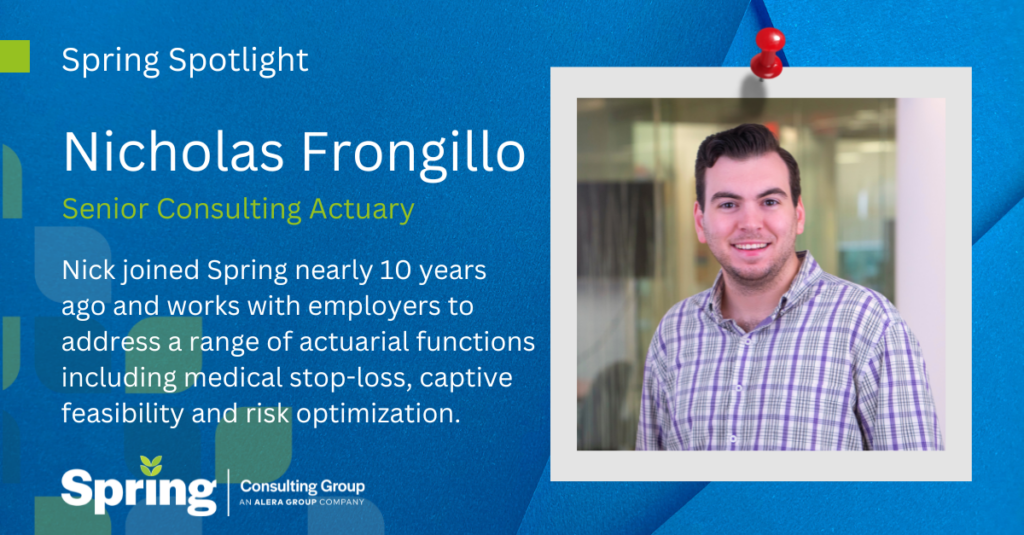
Title:
Senior Consulting Actuary
Joined Spring:
I joined Spring in May 2014, shortly after graduating from Northeastern.
Hometown:
Central MA
At Work Responsibilities:
My actuarial focus is mainly health and medical stop-loss.
Outside of Work Hobbies/Interests:
Sports
Fun Fact:
I’ve been known to card count.
Describe Spring in 3 Words:
Never a dull Moment!
Favorite Movie/TV Show:
Inception/Seinfeld
Favorite Food:
Cheese
Favorite Place Visited:
Italy
Favorite Band/Musician:
Changes by the day!
If You Were a Superhero, Who Would You Be?
Batman.
Name One Thing On Your Bucket List:
Retire
What is One of Your Proudest Moments?:
I don’t know that I have any singular big ones, but I am proud every time we get positive client feedback
If You Win the Lottery, What is the First Thing You Would Do?
Invest!
What are You Passionate About?
Financial Literacy